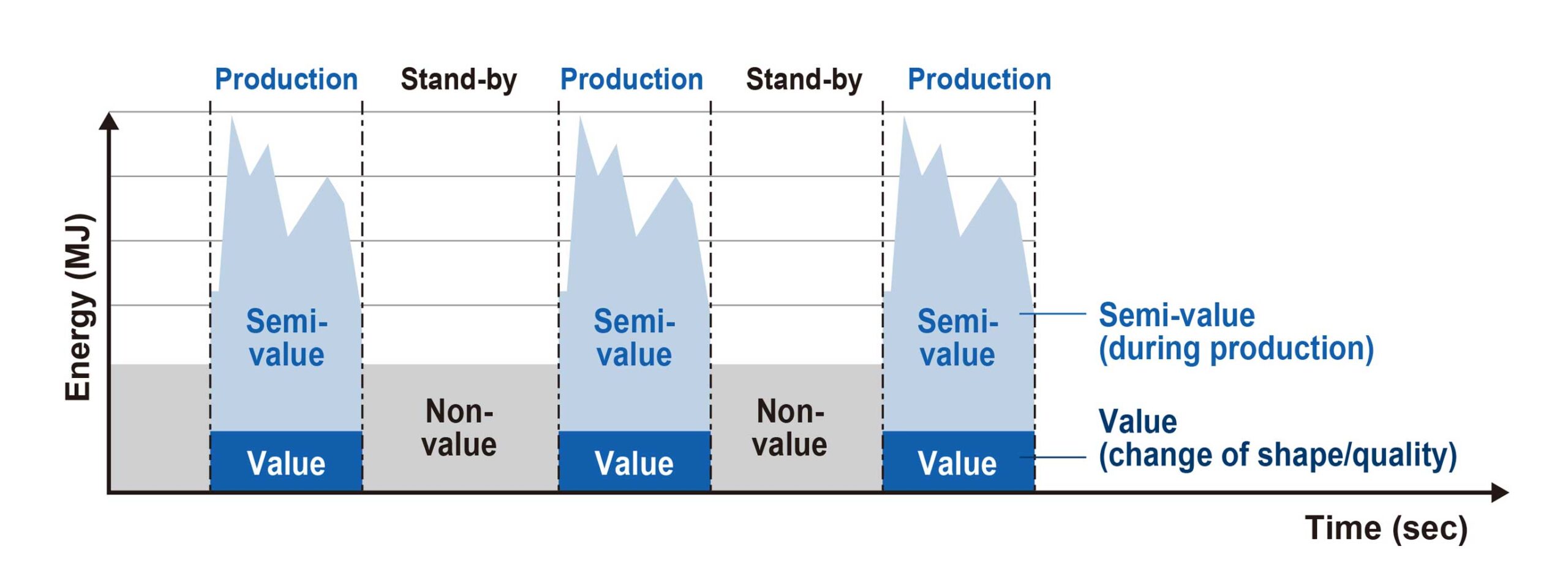Advancing toward carbon neutrality at our own plants through the operation of “Theoretical Value Energy”
Yamaha Motor has brought forward to 2035 the goal of achieving carbon neutrality at its own plants, including those overseas, in the “Yamaha Motor Group Environmental Plan 2050”. Various initiatives are currently being accelerated to realize this new target. Under these circumstances, the Hamamatsu Robotics Plant, which was undergoing expansion and renovation with the aim of doubling its production capacity, has begun operations as our first all-electric factory.
Carbon neutrality also contributes to “ease of work”
 The overall plan for achieving carbon neutrality is shown in the chart above. Plan to reduce electricity by 92% from 2010 levels by 2035 and offset the remaining non-electric CO₂ using internationally recognized methods.
The overall plan for achieving carbon neutrality is shown in the chart above. Plan to reduce electricity by 92% from 2010 levels by 2035 and offset the remaining non-electric CO₂ using internationally recognized methods.
“Reducing CO₂ makes manufacturing sites quieter, cooler, and cleaner, and extends the life of equipment and machinery. Since our efforts toward carbon neutrality are a scrum job with the manufacturing site, we are happy to hear from factory workers who feel comfortable working there, “It’s more comfortable now, thank you!” I am just as happy to hear that feedback of our efforts from the factory staff as it becomes carbon neutral have yielded numerical reductions. “, said the person in charge of from the Plant Engineering Division of our company. We have set a target of achieving carbon neutrality at our own factories by 2035 including overseas sites and are accelerating our efforts to realize a decarbonized society. As one of the steps toward this goal, we have begun operations at our Hamamatsu Robotics Plant (photo on cover), which is our first plant to achieve carbon neutrality.
The cornerstones of our approach to carbon neutrality are “minimization” and “cleanliness” of energy consumption. “Minimization” is an activity to reduce the absolute amount of energy consumption based on our original “Theoretical Value Energy” concept. On the other hand, “clean energy” is an activity to switch to cleaner energy through the introduction of renewable energy generation facilities and CO₂ free electricity. Furthermore, with regard to fossil-based energy, we are also hurrying to shift to alternative energy sources such as hydrogen and electricity in what are called high-temperature processes, such as casting and painting.

Accelerate efforts with our unique “Theoretical Value Energy”

“In order to achieve our goal, we have to reduce our emissions by 3% every year. We must step up another gear or two,” said the person in charge. The Japanese Agency for Natural Resources and Energy has imposed a 5% reduction obligation on factories designated for energy management over a five-year period, so we are aiming to achieve carbon neutrality about three times faster than before. (Figures for Japan)
One of the most visible and significant results is our proprietary method of minimizing power consumption, called “Theoretical Value Energy,” as mentioned above.
“Theoretical Value Energy” classifies all energy consumption into “value,” “semi-value,” and “no value,” and aims for a breakthrough by increasing the ratio of “value” as much as possible. For example, energy consumed when equipment is on standby is classified as “valueless,” and the goal is to reduce valueless energy to zero by introducing control technologies that automatically shut down equipment. The concept and results of this “Theoretical Value Energy” have attracted a great deal of attention, and the Energy Conservation Center of Japan has awarded it the “Energy Conservation Grand Prize” (2022).
We are “working in scrum with our manufacturing sites” –. In our factories around the world, stickers indicating that the equipment is carbon neutral are beginning to appear. By 2035, nearly all of our manufacturing facilities around the world will have these gold and silver certificates shining on them.

Overview of “Yamaha Motor Group Environmental Plan 2050”
Über Yamaha Robotics SMT Section
Die Yamaha Surface Mount Technology (SMT) Section, eine Unterabteilung der Yamaha Motor Robotics Business Unit der Yamaha Motor Corporation, produziert eine umfassende Palette von Systemen für die Hochgeschwindigkeits-Inline-Elektronikmontage. Diese 1 STOP SMART SOLUTION umfasst Lotpastendrucker, Bestückungsautomaten, 3D-Lotpasteninspektionsmaschinen, 3D-Baugruppeninspektionsmaschinen, Flip-Chip-Hybrid-Bestücker, Dispenser, intelligente Bauteillagerung und Management-Software.
Diese Systeme, die den Yamaha-Ansatz in die Elektronikfertigung bringen, legen den Schwerpunkt auf eine intuitive Bedienerführung, eine effiziente Koordination zwischen allen Inline-Prozessen und eine Modularität, die es Anwendern ermöglicht, die neusten Fertigungsanforderungen zu erfüllen. Die Kompetenzen der Gruppe bei der Steuerung von Servomotoren und der Kamera-basierten Bildverarbeitungssysteme gewährleisten extreme Genauigkeit bei hoher Geschwindigkeit.
Die aktuelle Produktlinie umfasst die neueste YR-Maschinengeneration mit hochentwickelten Automatisierungsfunktionen für die Programmierung, Einrichtung und Umrüstung sowie die neue YSUP-Managementsoftware mit hochmodernen Grafiken und integrierter Datenanalyse.
Durch die Bündelung der Kompetenzen in den Bereichen Design und Technik, Herstellung, Vertrieb und Service gewährleistet die Yamaha SMT Section betriebliche Effizienz und einen einfachen Support-Zugang für Kunden und Partner. Mit regionalen Niederlassungen in Japan, China, Südostasien, Europa und Nordamerika bietet das Unternehmen eine wahrhaft globale Präsenz.
